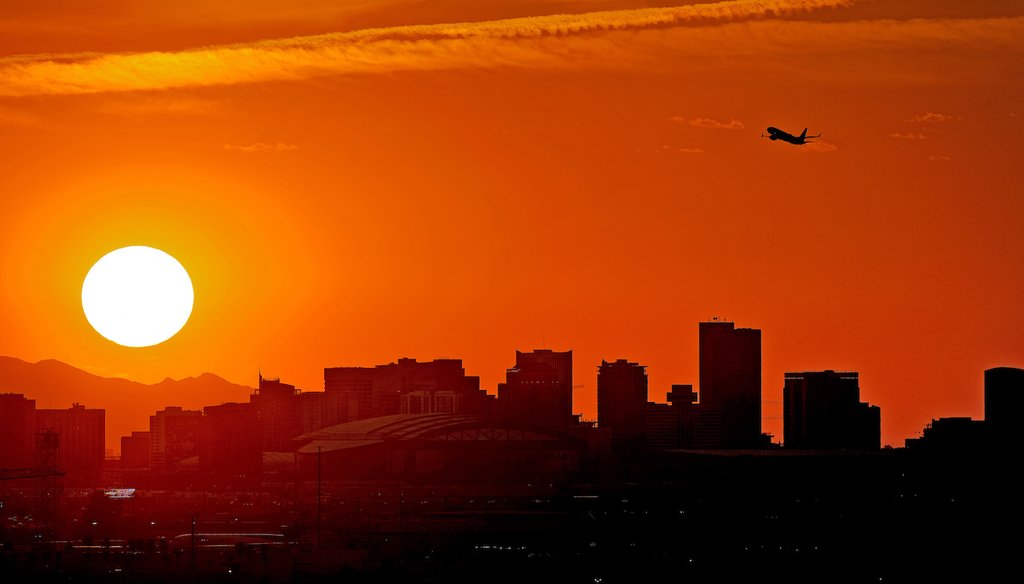Stand up for the facts!
Our only agenda is to publish the truth so you can be an informed participant in democracy.
We need your help.
I would like to contribute

A jet takes flight from Sky Harbor International Airport as the sun sets over Phoenix on July 12, 2023, a day of extreme heat. (AP)
If Your Time is short
-
With record-setting temperatures worldwide this summer, cities are confronting the problem of “urban heat islands,” areas that experience higher temperatures because of dense building and lack of green space.
-
Communities are responding with short-term steps such as cooling centers and long-term measures such as tree planting. But experts say more communities must plan for extreme heat, incorporating mitigation into urban design.
Having just experienced the hottest month ever recorded on Earth, and facing predictions of more extreme temperatures, U.S. cities are confronting the unique problem of "urban heat islands," areas that experience higher temperatures because of dense building and lack of green space.
Cities, with heat-absorbing asphalt, steel and cement, are turning to "cool" building materials and are planting more trees in an effort to ease the heat island effects.
But there is a gap. Even in cities such as Phoenix, which uses novel approaches including a heat management office, heat-related deaths continue. And experts warn that the extreme heat will continue.
"My sense is that July 2023 will likely be one of the cooler Julys of the next several decades," said Vivek Shandas, a researcher on climate change’s effects on cities and founder of the Sustaining Urban Places Research Lab at Portland State University. "Mostly, cities are woefully underprepared."
Several measures show that temperatures in July 2023 were exceptional:
-
Globally, July was the hottest month ever recorded, according to the European Union’s Copernicus Climate Change Service and other organizations.
-
Phoenix endured the hottest month on record for any U.S. city, with an average temperature of 102.7 degrees. Temperatures reached 110 degrees or higher for a record 31 straight days.
-
More than 70% of the U.S. population experienced at least one day in July with extreme temperatures made at least three times likelier because of human-caused climate change, according to the nonprofit Climate Central climate change research group.
Extreme heat degrades infrastructure such as roads that were not designed for increasingly higher temperatures. The Kansas City Streetcar line, for example, buckled in July because of high heat and had to shut down for two weeks for repairs.
The heat also increases the chances of electricity blackouts because the national grid has not been systematically upgraded in decades. And excessive heat can contribute to climate change, Shandas said, because of the energy required to respond to the heat, such as increased use of air conditioners, which tax grids and emit greenhouse gases.
Importantly, the heat also takes a human toll.
During the July heat wave, the rate of heat-related illness recorded in emergency departments was highest in the Arizona-California-Nevada region, where the average temperature for the week ended July 29 in some cities exceeded 100 degrees, according to the federal Centers for Disease Control and Prevention. The heat-illness rate in this region was 973 per 100,000 emergency department visits — more than six times higher than the rate in the least-affected region of Washington-Oregon-Idaho.
Urban areas can become heat islands because asphalt, steel, brick and cement in cities absorb heat, whereas in rural areas, trees and plants act as a natural air conditioner.
Daytime temperatures in urban areas are as much as 7 degrees higher than in outlying areas, according to the Environmental Protection Agency. City neighborhoods with lower incomes and more people of color tend to suffer greater health effects, the EPA found in a review of studies.
Even within a city, said Shandas, lack of tree coverage can cause temperatures in some neighborhoods to be 20 degrees higher than in others.
Maricopa County, Arizona, which includes Phoenix, has an association of governments that manages a heat relief network with more than 90 daytime cooling centers, but heat-related deaths have persisted. In 2023, through July 29, Maricopa County reported 39 heat-associated deaths, down from 42 at the same point in 2022. But the number of heat-associated deaths still under investigation was 312, compared with 282 at the same time last year.
Beyond immediate responses, tree planting is one long-term approach cities are pursuing. Trees, bushes and tall grasses lower temperatures by providing shade and cooling through evaporation and transpiration — a process in which trees and vegetation absorb water through their roots and cool surroundings by releasing water vapor into the air through their leaves. And research shows that trees help reduce heat-wave deaths and reduce carbon in the atmosphere.
Both federal and city initiatives aim to increase tree coverage:
-
President Joe Biden said July 27 that the U.S. Forest Service will award more than $1 billion in grants to help cities and towns plant trees as a long-term plan to repel heat.
-
The Phoenix Office of Heat Response and Mitigation aims to provide an average of 25% tree coverage across the city by 2030, roughly double the coverage when the city’s tree and shade master plan was produced in 2010.
-
Adding trees and vegetation — along with making roofs and pavements reflect, rather than absorb, heat — could save about 1 in 4 lives during heat waves in Los Angeles County, according to a peer-reviewed study by researchers from UCLA and other institutions.
Ultrawhite paint and green roofs can help buildings reflect heat instead of absorbing it.
A Purdue University-led team created a white paint that increases sunlight reflection and can cool daytime surfaces by as much as 8 degrees. It is not expected to be commercially available until at least mid-2024. But the team’s peer-reviewed research found that the paint "is among the highest of radiative cooling solutions" and compatible with the commercial paint fabrication process.
Green roofs, or rooftop gardens, cut temperatures for roof surfaces by up to 40 degrees, according to the EPA. The vegetative layer provides shade, removes heat from the air and reduces temperatures of the surrounding air. The City of Chicago targeted heat islands by providing financial incentives for rooftop gardens, like the one atop City Hall.
Shandas said cities and counties need to dedicate resources to long-term solutions that go beyond trees.
Phoenix (2021), Los Angeles (2022) and Miami-Dade County (2021) created "chief heat officers" to coordinate heat mitigation, but they are the only municipalities with such positions, Axios reported.
Some communities have developed heat response plans, but those plans should be tailored, an April study led by the University of Washington suggested. Researchers examined heat action plans in 21 municipalities with populations exceeding 200,000 and recommended increasing targeted strategies for people most at-risk — those older than 65, with chronic illnesses and experiencing homelessness.
In another peer-reviewed study, researchers from the University of Washington and other institutions surveyed 38 U.S. communities with populations of more than 200,000. The researchers concluded that municipalities could improve their heat action plans by formally evaluating the plans and by targeting emergency communications and cooling centers to at-risk populations that include communities of color.
"We’re hoping to see a lot more plans." Shandas said. "They really need a long-term perspective for making places cooler and providing sufficient resources during those events so it’s not only a rapid, emergency reaction to heat waves."
Cities also should adopt codes that require developers to design buildings and use building materials that account for heat.
"We know that the writing is on the wall and we have a pretty good sense of where to intervene and what we need to do," he said.
RELATED: You and your neighbors, a virtual power plant? Growing effort is money-saving and climate friendly
RELATED: Red light on ‘greenwashing’? US regulatory agency takes fresh look at deceptive climate claims
RELATED: Clean slate? ‘Carbon capture’ of CO2 emissions seen as technology that’s a climate solution and risk
RELATED: What role does natural gas play in a ‘clean energy’ future? Separating spin from science in TV ads
RELATED: Billions of dollars are being invested in pricey ‘green’ hydrogen. Is it a viable climate solution?
Our Sources
Copernicus Climate Change Service, "July 2023 sees multiple global temperature records broken," July 27, 2023
Bloomberg News, "Texas power prices to surge 800% on Sunday amid searing heat," Aug. 5, 2023
Scientific American, "July 2023 Is hottest month ever recorded on Earth," July 27, 2023
Washington Post, "Phoenix just posted the hottest month ever observed in a U.S. city," Aug. 1, 2023
Washington Post, "These places baked the most during Earth’s hottest month on record," Aug. 2, 2023
Twitter, Arizona State Climate Office tweet, Aug. 1, 2023
Twitter, National Weather Service Phoenix tweet, July 31, 2023
American Journal of Public Health, "Planning to reduce the health impacts of extreme heat: A content analysis of heat action plans in local United States jurisdictions," May 2023
Nature.org, "Heat Action planning guide for neighborhoods of greater Phoenix," accessed Aug. 2, 2023
PolitiFact, "Joe Biden said heat kills more Americans than floods, hurricanes and tornadoes combined. Is it true?", July 28, 2023
Baltimore City Health Department, "Health commissioner declares code red extreme heat alert for Tuesday through Wednesday; first of the season," June 28, 2021
New York City Mayor’s Office of Climate and Environmental Justice, "Be a Buddy," accessed Aug. 4, 2023
The White House, "Remarks by President Biden on actions to p rotect communities from extreme heat," July 27, 2023
The Guardian, "‘A bad perfect storm’: the US cities where temperatures have sizzled for 70 days," July 21, 2023
Interview, urban climate expert Luis Ortiz, atmospheric science professor at George Mason University, Aug. 1, 2023
Grist, "Can cities eliminate heat-related deaths in a warming world? Phoenix is trying," Jan. 24, 2023
Meta, 8 Billion Trees "He never expected it to go viral" ad, started running July 29, 2023
Maricopa Association of Governments, "Heat Relief Network," accessed Aug. 2, 2023
City of Phoenix, "Tree and Shade Master Plan," 2010
City of Phoenix, "City of Phoenix Summer 2023 Heat Response Plan," April 20, 2023
Centers for Disease Control and Prevention, "Weekly Heat-Related Illness, July 23-29, 2023," accessed Aug. 1, 2023
Centers for Disease Control and Prevention, "Heat Exposure Data — August 2023 Forecast," accessed Aug. 1, 2023
Associated Press, "Cities have long made plans for extreme heat. Are they enough in a warming world?", July 9, 2023
Climate Central, "Fingerprints of climate change during Earth’s hottest month," Aug. 1, 2023
Axios, "Too much heat, too few ‘chief heat officers,’" July 12, 2023
International Journal of Biometeorology, "Increasing trees and high‑albedo surfaces decreases heat impacts and mortality in Los Angeles, CA," March 24, 2022
BMC Public Health, "Survey of extreme heat public health preparedness plans and response activities in the most populous jurisdictions in the United States," May 3, 2023
Environmental Health Perspectives, "Efficacy of cooling centers for mitigating physiological strain in older adults during daylong heat exposure: A laboratory-based heat wave simulation," June 1, 2023
Email, City of Phoenix spokesperson Keyera Williams, Aug. 2, 2023
Maricopa County Public Health Department, "2022 Heat Deaths Report," June 2023
Maricopa County Public Health Department, "2023 Weekly Heat Report," accessed Aug. 4, 2023
NASA, "What Is an Urban Heat Island?", Aug. 3, 2023
Environmental Protection Agency, "Heat Island Effect," July 20, 2023
Environmental Protection Agency, "Heat Islands and Equity," Aug. 3, 2023
Environmental Protection Agency, "Using Trees and Vegetation to Reduce Heat Islands," Aug. 11, 2023
Environmental Protection Agency, "Using Green Roofs to Reduce Heat Islands," June 28, 2023
Environmental Protection Agency, "Chicago, IL Uses Green Infrastructure to Reduce Extreme Heat," May 16, 2023
PolitiFact, "What Herschel Walker gets wrong, and right, about federal funding for more trees," Sept. 1, 2022
ACS Applied Materials & Interfaces, "Ultrawhite BaSO4 Paints and Films for Remarkable Daytime Subambient Radiative Cooling," April 15, 2021
Interview, Vivek Shandas, geography professor and founder of the Sustaining Urban Places Research Lab at Portland State University, who does research on the impact of climate change on cities, Aug. 4, 2023
Interview, Maricopa Association of Governments human services planner Cleo Warner, Aug. 4, 2023
Federal Emergency Management Agency, "Extreme Heat," accessed Aug. 4, 2023
Email, climate change researcher Dr. David Eisenman, medicine and public health professor at the David Geffen School of Medicine and the Fielding School of Public Health at UCLA, Aug. 4, 2023


























